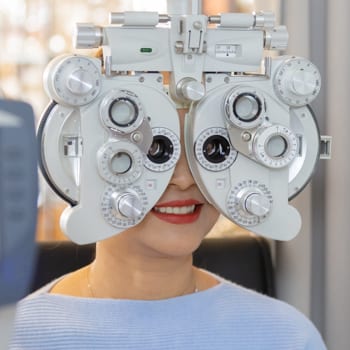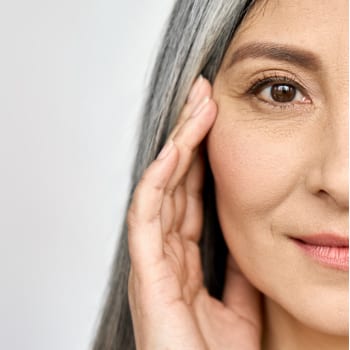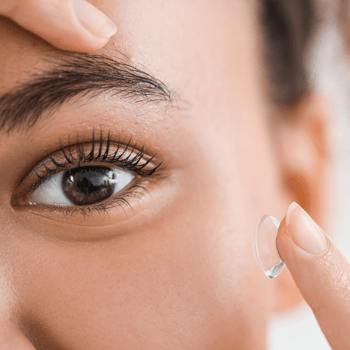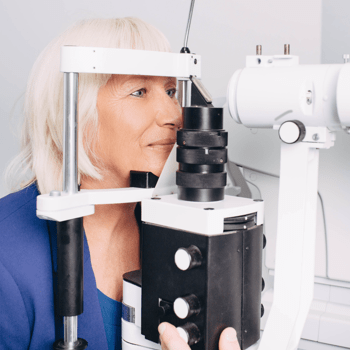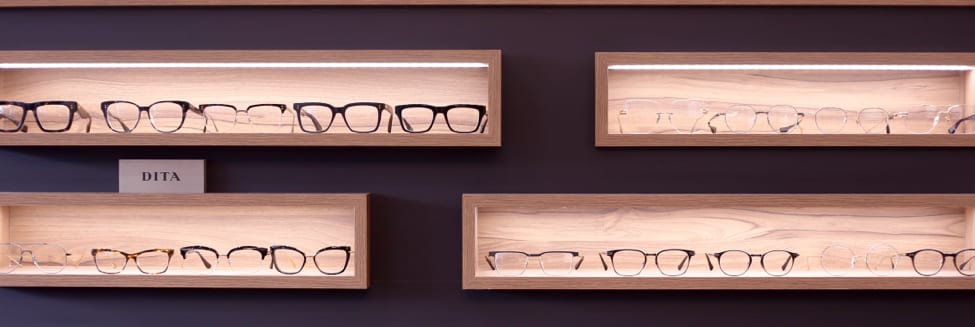Improving vision isn’t just about achieving 20/20 clarity; it’s also about enhancing the way we engage with and understand the world around us.
Vision therapy is a non-invasive and personalized program to improve visual skills, like eye function and coordination to facilitate finer visual and ocular health outcomes.
Anyone, regardless of age, can experience the benefits of vision therapy. The best time to start is when vision concerns are detected, as early intervention facilitates better visual outcomes. Innovative screening tools like RetinaLogik’s AI-driven technology are making it easier to detect early visual impairments, allowing for timely intervention.
What is Vision Therapy?
Vision therapy is a customized program designed to improve visual skills by targeting brain-eye communication, teaching the eyes how to work together more efficiently.
As humans, we have binocular vision, where each eye holds slightly different pieces of visual information, but both eyes are still meant to work together.
Visual therapy helps correct any problems in binocular vision by realigning and strengthening ocular muscles by focusing on:
- Ocular motility
- Accommodation
- Depth perception
- Eye tracking
- Focus adjustment
- Eye coordination
Glasses and contacts are a great way to improve visual clarity, but don’t address every vision-related concern. Vision therapy steps in by addressing the functional and neurological aspects of vision. New advancements in AI-based diagnostics, like RetinaLogik, are enhancing the ability to identify candidates for vision therapy earlier by detecting subtle vision processing issues.
How Does Vision Therapy Work?
Recognizing that vision is a learned skill, like playing an instrument, rather than innate, is foundational to vision therapy. It identifies that visual deficiencies can be overcome by learning.
Vision therapy works by harnessing the brain’s ability to form new neural connections, known as neuroplasticity. Optometrists specializing in vision therapy develop a personalized treatment plan targeting visual functions to refine a patient’s visual skills.
While therapy sessions are highly individualized, optometrists use a variety of resources, including specific exercises, tools, and techniques, to enhance how the eyes focus, move, and align.
Through repetitive practice and gradually increasing task complexity, therapy strengthens the brain-eye connection, making it more efficient. This holistic approach helps improve reading, learning, hand-eye coordination, and spatial awareness.
When is Vision Therapy Needed?
The benefits of vision therapy are substantial, but not necessary for everyone.
It’s primarily designed for patients experiencing specific visual challenges that can’t be sufficiently addressed through corrective lenses alone, for example:
- Strabismus (Crossed Eyes): Vision therapy can help train muscles and the brain to correct eye alignment.
- Convergence insufficiency: When the eyes struggle to focus together on nearby objects, therapy can improve coordination and reduce symptoms like double vision.
- Amblyopia: Commonly known as “lazy eye,” this condition can often be improved with targeted training that encourages eye-brain communication.
- Visual processing issues: Challenges with tracking, depth perception, or reading comprehension can be addressed to strengthen cognitive-visual links.
Beyond sharp vision, basic visual skills are necessary for maintaining good ocular health and vision. A problem with any one of these skills can impact one’s quality of life, especially for children, who rely on these skills for learning.
Some signs that suggest a patient may benefit from vision therapy generally include:
- Difficulty maintaining focus on reading or other close-up tasks.
- Frequent headaches or eye strain while working or studying.
- Skipping lines or losing place while reading.
- Trouble with hand-eye coordination or spatial awareness.
- Complaints of blurry or double vision.
- Difficulty concentrating, particularly on visual tasks.
- Tilted head position or covering one eye to see clearly
Early screening with AI-assisted tools like RetinaLogik can help detect these issues before they impact academic performance or daily life.
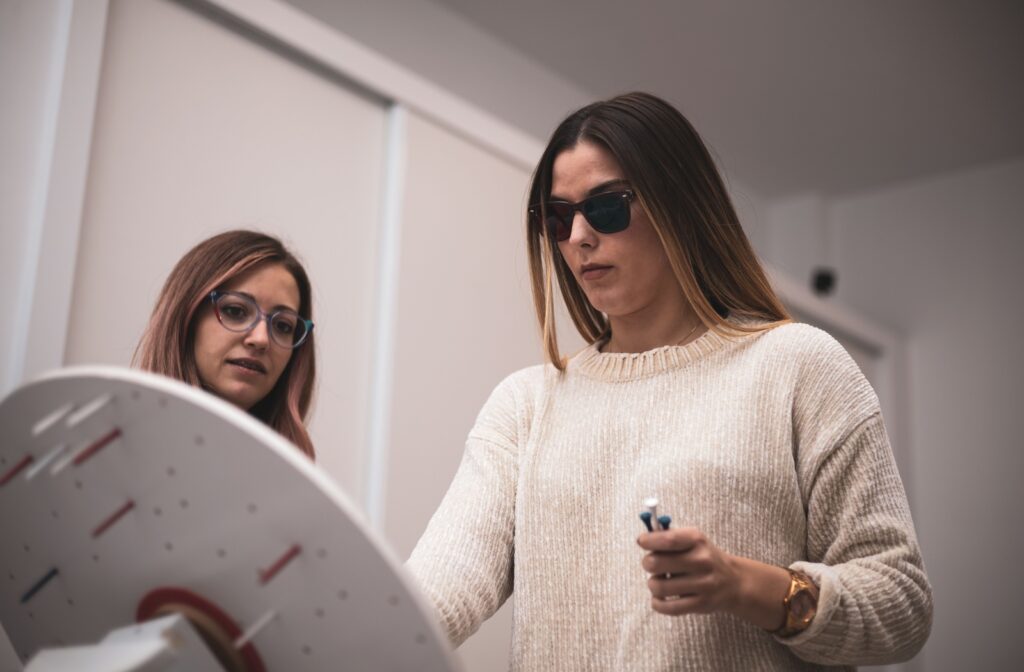
When is the Right Time for Vision Therapy?
The good news is there’s no strict age limit for vision therapy.
Both children and adults can benefit from the skills learned in these programs because the brain’s ability to form new neural connections is ongoing. However, younger patients tend to adapt more quickly due to greater neuroplasticity.
While adults may take longer to see results, vision therapy remains highly effective in improving visual function at any age.
When Should Someone Start Vision Therapy?
The earlier a visual concern is identified, the better. Early intervention prevents long-term complications and ensures faster progress.
Routine eye exams play a pivotal role in identifying vision concerns like amblyopia or convergence insufficiency. Children, in particular, should undergo annual eye exams since their eyes are still developing. AI-based screening solutions like RetinaLogik can enhance these exams by detecting subtle functional vision issues that may require therapy.
For children, unaddressed visual concerns can lead to academic struggles and difficulty with activities like reading, sports, and attention span. Early intervention can significantly improve learning ability, confidence, and quality of life.
Addressing symptoms as soon as they appear allows therapy to target and improve immediate concerns while preventing further decline in visual performance. Despite the benefits of starting young, patients shouldn’t feel discouraged if vision therapy begins later.
Adults can also benefit from vision therapy if they experience symptoms such as:
- Chronic eye strain
- Double vision
- Difficulty focusing at work
- Frequent headaches from near tasks
Ultimately, there’s no wrong time to commit to improving visual health and function, but early intervention encourages better outcomes.
Schedule a Visit
Vision therapy addresses underlying vision concerns using specialized exercises, tools, and techniques to encourage better visual outcomes. The key to achieving ideal results is early detection, consistency, and starting as soon as possible.
Emerging AI-driven technologies like RetinaLogik are making it easier than ever to screen for vision therapy candidates, ensuring that those who need treatment receive timely intervention.
Contact our team at Foresee Eyecare to schedule a vision therapy consultation and explore how new technologies are enhancing vision care.

